一、介绍Vuex
Vuex 是一个专为 Vue.js 应用程序开发的状态管理模式。它采用集中式存储管理应用的所有组件的状态,并以相应的规则保证状态以一种可预测的方式发生变化,适合于构建中大型单页应用。
1、什么是状态管理模式?
看个简单的例子:
<!DOCTYPE html> <html> <head> <meta charset="utf-8"> <meta name="viewport" content="width=device-width"> <title>Vuex Demo 01</title> <script src="http://cdn.bootcss.com/vue/1.0.26/vue.min.js"></script> <script src="http://cdn.bootcss.com/vuex/0.8.2/vuex.min.js"></script> </head> <body> <!-- 2、view,映射到视图的数据counterValue; --> <h3>Count is {{ counterValue }}</h3> <div> <button @click="increment">Increment +1</button> <button @click="decrement">Decrement -1</button> </div> </body> <script> var app = new Vue({ el: 'body', store: new Vuex.Store({ // 1、state,驱动应用的数据源; state: { count: 0 }, mutations: { INCREMENT: function(state, amount) { state.count = state.count + amount }, DECREMENT: function(state, amount) { state.count = state.count - amount } } }), vuex: { getters: { counterValue: function(state) { return state.count } }, // 3、actions,响应在view上的用户输入导致的状态变化。 actions: { increment: function({ dispatch, state }){ dispatch('INCREMENT', 1) }, decrement: function({ dispatch, state }){ dispatch('DECREMENT', 1) } } } }) </script> </html>
代码中标识了:
1、state,驱动应用的数据源;
2、view,映射到视图的数据counterValue;
3、actions,响应在view上的用户输入导致的状态变化。
用简单示意图表示他们之间的关系:

我们知道,中大型的应用一般会遇到多个组件共享同一状态的情况:
1、多个视图依赖于同一状态
2、来自不同视图的行为需要变更同一状态
于是需要把组件的共享状态抽取出来,以一个全局单例模式管理,另外,需要定义和隔离状态管理中的各种概念并强制遵守一定的规则。
这就是 Vuex 背后的基本思想,借鉴了 Flux、Redux、和 The Elm Architecture。与其他模式不同的是,Vuex 是专门为 Vue.js 设计的状态管理库,以利用 Vue.js 的细粒度数据响应机制来进行高效的状态更新。
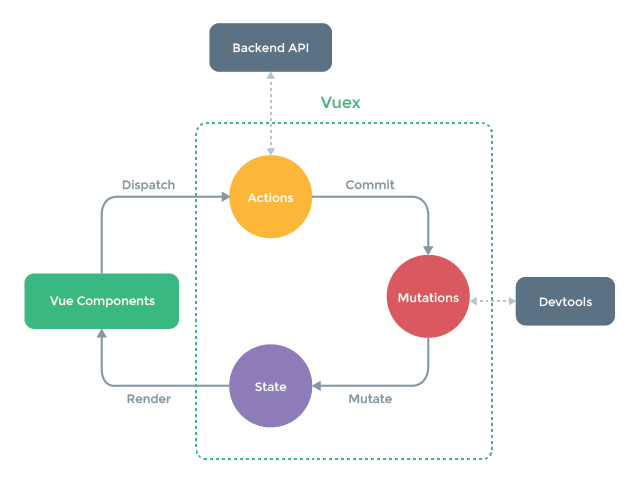
2、Vuex的核心概念
1、State: 单一状态树,用一个对象包含了全部的应用层级状态,作为一个『唯一数据源(SSOT)』而存在,每个应用将仅仅包含一个 store 实例。
2、Getters: Vuex 允许我们在 store 中定义『getters』(可以认为是 store 的计算属性)。
3、Mutations: Vuex 中的 mutations 非常类似于事件:每个 mutation 都有一个字符串的 事件类型 (type) 和 一个 回调函数 (handler)。这个回调函数就是我们实际进行状态更改的地方,并且它会接受 state 作为第一个参数。
4、Actions: 类似于 mutation,不同在于:①Action 提交的是 mutation,而不是直接变更状态;②Action 可以包含任意异步操作。
5、Modules: 为解决单一状态树导致应用的所有状态集中在一个store对象的臃肿问题,Vuex将store分割到模块(module)。每个模块拥有自己的 state、mutation、action、getters、甚至是嵌套子模块——从上至下进行类似的分割。
接着我们开始构建备忘录应用,在以下构建过程的介绍中,再加深理解上述概念。
二、环境安装
1.安装 vue-cli

2.初始化应用
vue init webpack vue-notes-demo
cd vue-notes-demo
npm install // 安装依赖包
npm run dev // 启动服务
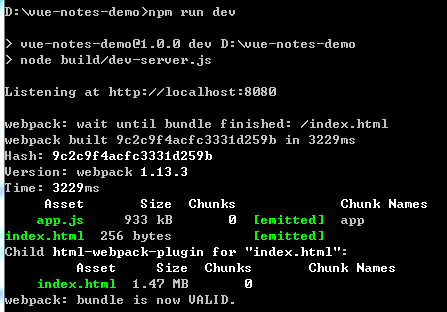
结果为:
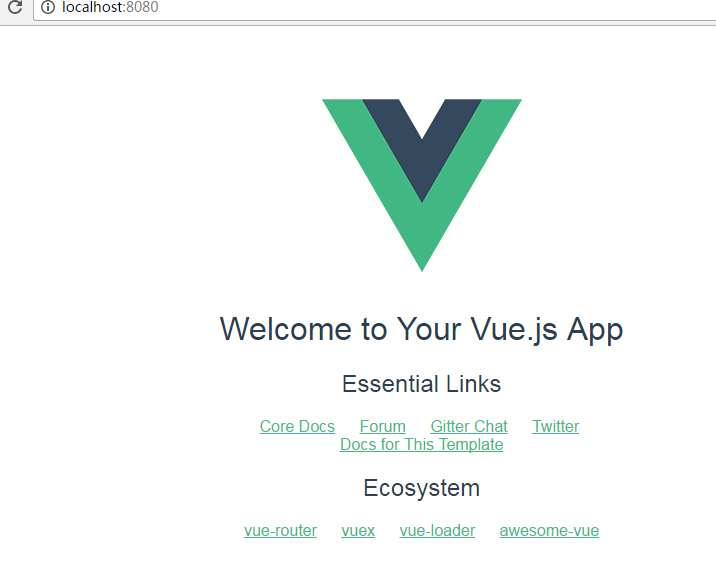
目录结构为:

三、功能模块
先看下我们要做的demo的效果为:
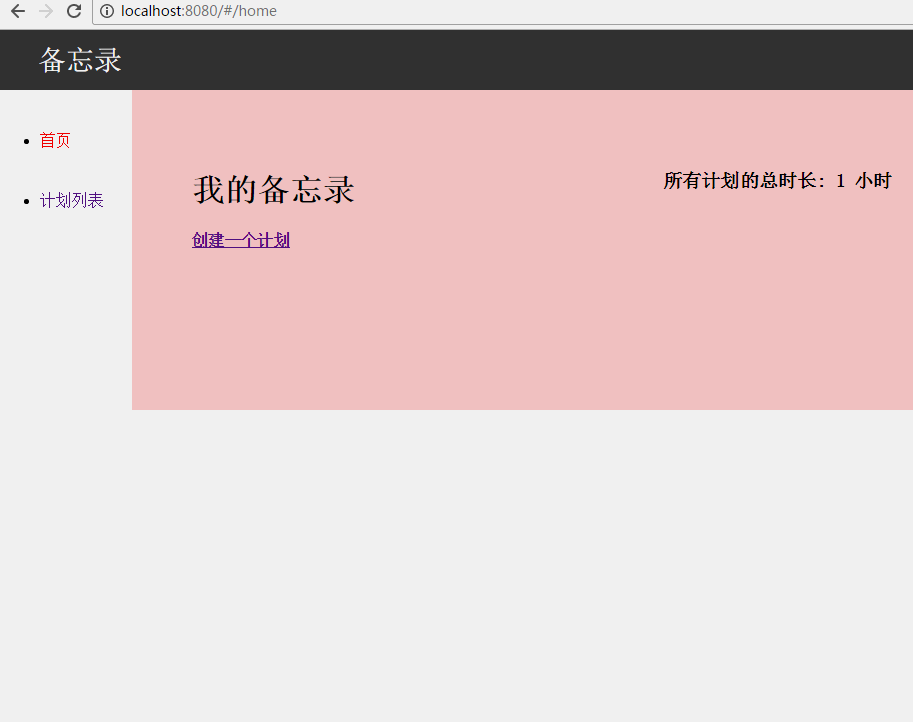
主要功能模块为:
-
新增计划,新增一个计划,编辑区显示空的计划内容。
-
移除计划,删除一个计划之后,计划列表少了该计划。
-
所有计划的总时长,将所有的计划时间加起来。
四、项目组件划分
在原来的目录结构的调整下,最终的目录结构为:
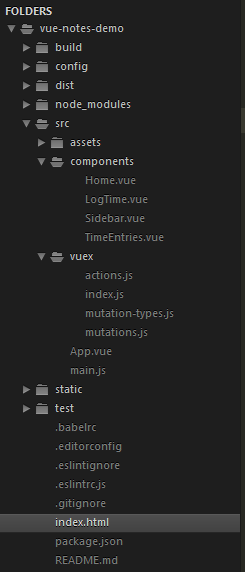
下面详细介绍下:
1、组件部分
1.首页组件:Home.vue
<template> <div class="jumbotron"> <h1>我的备忘录</h1> <p> <strong> <router-link to="/time-entries">创建一个计划</router-link> </strong> </p> </div> </template>
2.计算计划总时长组件:Sidebar.vue

<template> <div class="panel panel-default"> <div class="panel-heading"> <h3 class="text-center">所有计划的总时长: {{ time }} 小时</h3> </div> </div> </template> <script> export default { computed: { time() { return this.$store.state.totalTime } } } </script>
3.计划列表组件:TimeEntries.vue

<template> <div> <router-link v-if="$route.path !== '/time-entries/log-time'" to="/time-entries/log-time" class="btn create-plan"> 创建 </router-link> <div v-if="$route.path === '/time-entries/log-time'"> <h3>新的计划</h3> </div> <hr> <router-view></router-view> <div class="time-entries"> <p v-if="!plans.length"><strong>还没有任何计划(┬_┬),快去创建吧ヽ(●-`Д´-)ノ</strong></p> <div class="list-group"> <a class="list-group-item" v-for="(plan,index) in plans"> <div class="row"> <div class="col-sm-2 user-details"> <img :src="plan.avatar" class="avatar img-circle img-responsive" /> <p class="text-center"> <strong> {{ plan.name }} </strong> </p> </div> <div class="col-sm-2 text-center time-block"> <p class="list-group-item-text total-time"> <span class="glyphicon glyphicon-time">计划总时间:</span> {{ plan.totalTime }} </p> <p class="label label-primary text-center"> <span class="glyphicon glyphicon-calendar">开始时间:</span> {{ plan.date }} </p> </div> <div class="col-sm-7 comment-section"> <p>备注信息:{{ plan.comment }}</p> </div> <button class="btn btn-xs delete-button" @click="deletePlan(index)"> X </button> </div> </a> </div> </div> </div> </template> <script> export default { name : 'TimeEntries', computed : { plans () { return this.$store.state.list } }, methods : { deletePlan(idx) { // 减去总时间 this.$store.dispatch('decTotalTime',this.plans[idx].totalTime) // 删除该计划 this.$store.dispatch('deletePlan',idx) } } } </script>
4.新增计划组件:LogTime.vue

<template> <div class="form-horizontal"> <div class="form-group"> <div class="col-sm-6"> <label>开始日期:</label> <input type="date" class="form-control" v-model="date" placeholder="Date" /> </div> <div class="col-sm-6"> <label>总时间 :</label> <input type="number" class="form-control" v-model="totalTime" placeholder="Hours" /> </div> </div> <div class="form-group"> <div class="col-sm-12"> <label>备注 :</label> <input type="text" class="form-control" v-model="comment" placeholder="Comment" /> </div> </div> <button class="btn btn-primary" @click="save()">保存</button> <router-link to="/time-entries" class="btn btn-danger">取消</router-link> <hr> </div> </template> <script> export default { name : 'LogTime', data() { return { date : '', totalTime : '', comment : '' } }, methods:{ save() { const plan = { name : 'eraser', image : 'https://pic.cnblogs.com/avatar/504457/20161108225210.png', date : this.date, totalTime : this.totalTime, comment : this.comment }; this.$store.dispatch('savePlan', plan) this.$store.dispatch('addTotalTime', this.totalTime) this.$router.go(-1) } } } </script>
2、vuex中用来存储数据的划分为:
1.初始化vuex.Store: index.js
import Vue from 'vue' import Vuex from 'vuex' import mutations from './mutations' import actions from './actions' Vue.use(Vuex); const state = { totalTime: 0, list: [] }; export default new Vuex.Store({ state, mutations, actions })
State: 单一状态树,用一个state对象包含了全部的应用层级状态,代码中只new 了一次store实例 Vuex.Store。
2.负责触发事件和传入参数:actions.js

import * as types from './mutation-types' export default { addTotalTime({ commit }, time) { commit(types.ADD_TOTAL_TIME, time) }, decTotalTime({ commit }, time) { commit(types.DEC_TOTAL_TIME, time) }, savePlan({ commit }, plan) { commit(types.SAVE_PLAN, plan); }, deletePlan({ commit }, plan) { commit(types.DELETE_PLAN, plan) } };
实践中,我们会经常会用到 ES2015 的 参数解构 来简化代码(特别是我们需要调用 commit 很多次的时候):
actions: { increment ({ commit }) { commit('increment') } }
3.注册各种数据变化的方法: mutations.js

import * as types from './mutation-types' export default { // 增加总时间 [types.ADD_TOTAL_TIME] (state, time) { state.totalTime = state.totalTime + time }, // 减少总时间 [types.DEC_TOTAL_TIME] (state, time) { state.totalTime = state.totalTime - time }, // 新增计划 [types.SAVE_PLAN] (state, plan) { // 设置默认值,未来我们可以做登入直接读取昵称和头像 const avatar = 'https://pic.cnblogs.com/avatar/504457/20161108225210.png'; state.list.push( Object.assign({ name: 'eraser', avatar: avatar }, plan) ) }, // 删除某计划 [types.DELETE_PLAN] (state, idx) { state.list.splice(idx, 1); } };
使用常量替代 mutation 事件类型在各种 Flux 实现中是很常见的模式。这样可以使 linter 之类的工具发挥作用,同时把这些常量放在单独的文件中可以让你的代码合作者对整个 app 包含的 mutation 一目了然:
// mutation-types.js
export const SOME_MUTATION = 'SOME_MUTATION'
mutations: {
// 我们可以使用 ES2015 风格的计算属性命名功能来使用一个常量作为函数名
[SOME_MUTATION] (state) {
// mutate state
}
}
4.记录所有的事件名: mutation-types.js

// 增加总时间或者减少总时间 export const ADD_TOTAL_TIME = 'ADD_TOTAL_TIME'; export const DEC_TOTAL_TIME = 'DEC_TOTAL_TIME'; // 新增和删除一条计划 export const SAVE_PLAN = 'SAVE_PLAN'; export const DELETE_PLAN = 'DELETE_PLAN';
配合上面常量替代 mutation 事件类型的使用
3、初始化部分
入口文件渲染的模版index.html比较简单:
<!DOCTYPE html> <html> <head> <meta charset="utf-8"> <title>vue-notes-demo</title> </head> <body> <div id="app"> <router-view></router-view> </div> </body> </html>
入口文件main.js的代码:

import Vue from 'vue'; import App from './App'; import Home from './components/Home'; import TimeEntries from './components/TimeEntries.vue' import VueRouter from 'vue-router'; import VueResource from 'vue-resource'; import store from './vuex/index'; // 路由模块和HTTP模块 Vue.use(VueResource); Vue.use(VueRouter); const routes = [ { path: '/home', component: Home }, { path : '/time-entries', component : TimeEntries, children : [{ path : 'log-time', // 懒加载 component : resolve => require(['./components/LogTime.vue'],resolve), }] }, { path: '*', component: Home } ] const router = new VueRouter({ routes // short for routes: routes }); // router.start(App, '#app'); const app = new Vue({ router, store, ...App, }).$mount('#app');
代码中
...App 相当于 render:h => h(App)
初始化组件App.vue为:

<!-- // src/App.vue --> <template> <div id="wrapper"> <nav class="navbar navbar-default"> <div class="container"> <a class="navbar-brand" href="#"> <i class="glyphicon glyphicon-time"></i> 备忘录 </a> <ul class="nav navbar-nav"> <li><router-link to="/home">首页</router-link></li> <li><router-link to="/time-entries">计划列表</router-link></li> </ul> </div> </nav> <div class="container"> <div class="col-sm-9"> <router-view></router-view> </div> <div class="col-sm-3"> <sidebar></sidebar> </div> </div> </div> </template> <script> import Sidebar from './components/Sidebar.vue' export default { components: { 'sidebar': Sidebar }, } </script> <style> .router-link-active { color: red; } body { margin: 0px; } .navbar { height: 60px; line-height: 60px; background: #333; } .navbar a { text-decoration: none; } .navbar-brand { display: inline-block; margin-right: 20px; width: 100px; text-align: center; font-size: 28px; text-shadow: 0px 0px 0px #000; color: #fff; padding-left: 30px; } .avatar { height: 75px; margin: 0 auto; margin-top: 10px; /* margin-bottom: 10px; */ } .text-center { margin-top: 0px; /* margin-bottom: 25px; */ } .time-block { /* padding: 10px; */ margin-top: 25px; } .comment-section { /* padding: 20px; */ /* padding-bottom: 15px; */ } .col-sm-9 { float: right; /* margin-right: 60px; */ width: 700px; min-height: 200px; background: #ffcccc; padding: 60px; } .create-plan { font-size: 26px; color: #fff; text-decoration: none; display: inline-block; width: 100px; text-align: center; height: 40px; line-height: 40px; background: #99cc99; } .col-sm-6 { margin-top: 10px; margin-bottom: 10px; } .col-sm-12 { margin-bottom: 10px; } .btn-primary { width: 80px; text-align: center; height: 30px; line-height: 30px; background: #99cc99; border-radius: 4px; border: none; color: #fff; float: left; margin-right: 10px; font-size: 14px; } .btn-danger { display: inline-block; font-size: 14px; width: 80px; text-align: center; height: 30px; line-height: 30px; background: red; border-radius: 4px; text-decoration: none; color: #fff; margin-bottom: 6px; } .row { padding-bottom: 20px; border-bottom: 1px solid #333; position: relative; background: #f5f5f5; padding: 10px; /* padding-bottom: 0px; */ } .delete-button { position: absolute; top: 10px; right: 10px; } .panel-default { position: absolute; top: 140px; right: 60px; } </style>
至此,实践结束,一些原理性的东西我还需要多去理解^_^
源代码:【vuex2.0实践】
参考:
